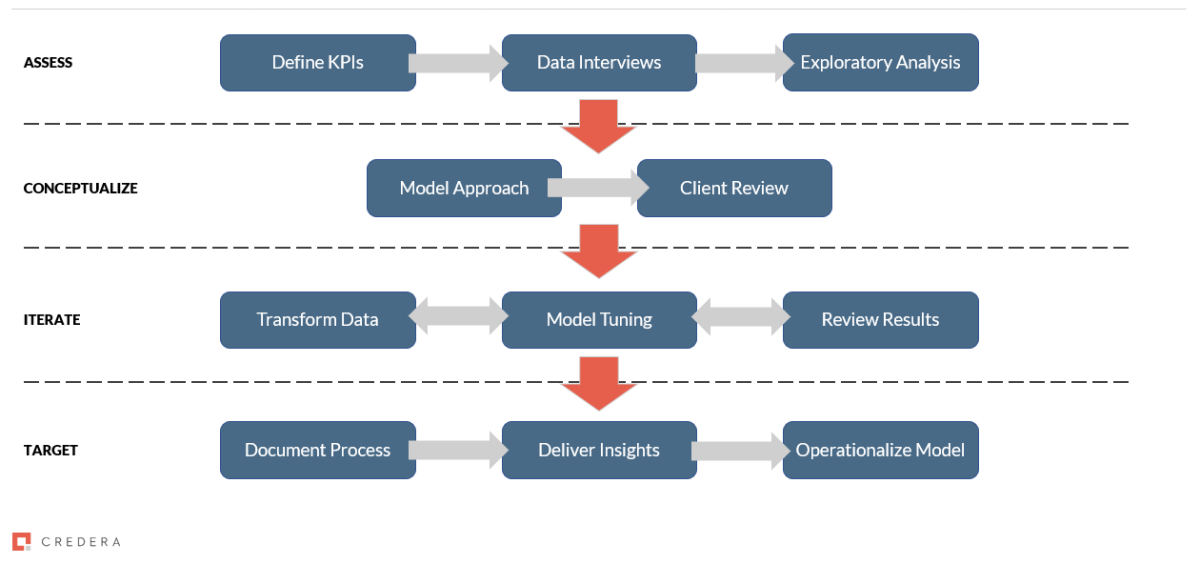
Machine learning (ML) is an exciting subset of artificial intelligence that enables companies to cross the threshold from reactive to predictive analytics as well as enable automation, bringing with it benefits such as increased revenue, reduced operational inefficiencies, and improved customer experience.
ML implementations can vary widely depending on the organization that seeks to implement it. Different goals, sizes, and industries mean that each implementation requires a degree of personalization. However, every project effort follows a similar process flow that acts as a launching pad to tailor the result to unique use cases.
At Credera, we have adapted this process flow into a standard approach for machine learning consulting that has helped many organizations break through the barriers of low analytical maturity into predictive and prescriptive analytics.
We have used this framework with a variety of company sizes from national to local and across industries such as home services, financial services, and retail. Our solutions have ranged from real-time detection of suspicious website traffic activity, dynamic ad displays, utilization of image recognition for inventory classification and customer experience improvements, and digitization and classification of millions of text documents each month.
Throughout this blog post, we will walk through our approach and highlight the importance of each step.
Our Machine Learning Project Method
Credera’s methodology consists of four steps: assess, conceptualize, iterate, and target. Each phase is vital to the implementation process and brings a unique set of lessons that build upon each other to deliver a solution that is tailored to each organization. Each of these steps and their sub-activities have been visualized below.

The Credera ML Consulting Implementation Process, source: Credera Data and Analytics Practice
1. Assess
Before anything is built or brainstormed, we must first assess the situation. This is one of most important and often overlooked steps in the process. To properly deliver the best model for the organization, we must first understand the problems the business is trying to solve, the goals for the engagement, and the current state of the data. This helps guide us toward the right models to accomplish the desired outcome.
Taking time to assess the problem, align the goals for the engagement, and define success-metric benchmarks ensures that the end goal stays paramount throughout the engagement and enables a successful initiative. During this phase, we perform a general data assessment to understand the client's current data quality, determine baselines that can be used to validate our model(s), and guide our initial model selection decision-making. This assessment also includes a data profiling and exploration exercise that dictates any preparatory work that needs to be done, such as data cleansing, data integrations, or feature engineering.
2. Conceptualize
The knowledge gleaned from the assessment phase is used to define an initial approach that we review with the organization to ensure alignment on the defined success indicators. Once reviewed, we begin building a proof of concept (POC). This POC is flexible and transforms over time as new information is gleaned and data is transformed.
We continue to review not only the initial approach but also our iterations throughout this process to ensure alignment on expectations from both Credera and the organization. We have found this inspires confidence in the direction of the initiative for all stakeholders. We also use this phase as an opportunity to increase transparency into the data product and development lifecycle, which ultimately supports knowledge transfer and change management efforts.
3. Iterate
Once the POC has been conceptualized and built, the iterate phase allows us to keep raising the bar on the model. We continue to modify and improve upon the POC using additional data transformation techniques, model tuning, model training with additional data, and frequent reviews with the organization until there is an acceptable score for production. The acceptable score is determined using the requirements defined in the assess phase and is an indication that the model is ready to be delivered.
The iterations typically take up most of the time spent on the implementation and require frequent touchpoints; however, they ensure the solution is optimized for the organization’s unique needs. They also verify that the outcome of the initiative provides tangible ROI toward any process efficiencies and monetary savings realized through the ML solution.
4. Target
In this phase, we present any findings from the previous steps, focusing on how the business can use these insights to achieve their goals and what that means going forward. Our iterative and collaborative process allows these insights to be delivered quickly, ensuring time to pivot and/or target quick wins. Throughout the initiative, Credera also helps evaluate the client’s existing data architecture and identify any necessary components or changes required to operationalize and productionize the model.
Credera keeps thorough records on how any model was built and any maintenance required for these models. These documents ensure a smooth knowledge transfer and help train and develop any client staff who will be managing the tool long term.
Machine Learning in Practice
We would love to help you consider how ML could be helpful to your organization and help you plan and work through this initiative. For more information, please reach out to us at findoutmore@credera.com. If you are interested in learning more about ML, please check out our previous blog posts on this topic here where we spotlight ML in financial services, explain the benefits of next best action decisioning, cover ML essentials, and discuss other general ML applications.
Contact Us
Ready to achieve your vision? We're here to help.
We'd love to start a conversation. Fill out the form and we'll connect you with the right person.
Searching for a new career?
View job openings





